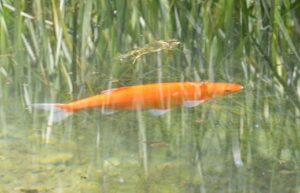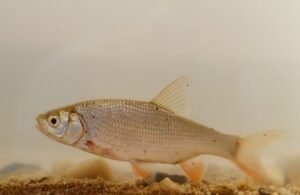Ide (Leuciscus idus)

Photo credit: Roman Jackson via iNaturalist

Photo credit: Noya Blokov via iNaturalist
French common name: Ide mélanote
Other English common names: ofre, golden ofre, silver ofre
Order: Cypriniformes
Family: Cyprinidae
Did you know? Ide are capable of hybridizing with other introduced carp species such as common carp and rudd!
Introduction
The ide (also known as orfe, golden orfe, or silver orfe) is a freshwater, invasive carp species belonging to the Cyprinidae family. This invasive carp is native to most of mainland Europe and Western Asia and became introduced into North America in the late 1800s for aquaculture and ornamental purposes. Eventual flooding events allowed it to escape public and commercial aquaculture operations and eventually enter natural waterways throughout the eastern United States. Recently acknowledged as a prohibited species under Ontario’s Invasive Species Act on January 1st, 2024, the ide was chosen for regulation based on its potential to cause ecological, social, or economic harm to Canada’s natural environments. Current distribution data for the ide is limited but has been recorded outside of its native range in nine U.S. states, including Maine, Connecticut, Pennsylvania, and New York. To date, there have been no positive detections of ide within Canadian waters, or anywhere within the Great Lakes basin (OFAH/OMNRF Invading Species Awareness Program, 2023).
The ide is a medium-sized fish with a bluntly pointed snout, scaleless head, thick minnow-shaped body, and a deeply forked tail. Two colour varieties of ide exist, silver and gold. Most commonly, ides found in wild environments appear dusty silver-gray in overall colouration, with shades of olive-brown above and a pearly white belly below. Golden varieties, however, are more predominant in captive environments such as ornamental ponds with a bright orange back, silvery-orange sides and belly, and bright orange tail and dorsal fin (EDDMapS.org). Similarly to goldfish, this occasional golden colouration is a natural occurrence caused by a genetic mutation amplified by selective breeding by people trying to produce more golden colour varieties. One of the most distinct characteristics of the ide is the bright orange-red pectoral, pelvic, and anal fins. Although females frequently appear larger than males, once fully mature, the ide can reach body lengths of 30 – 80 cm and weigh up to 8 pounds. Older adults sometimes display a raised/arched back (Alberta Invasive Species Council, 2016).

From March to June, adult ide spawn in schools, preferring to mate above gravel or weeds, which allow their fallen eggs to attach to the substate or vegetation below. These eggs are sticky and will adhere to almost any surface they come in contact with. Females will release eggs, as males fertilize them as they fall. Ide are prolific breeders, with females capable of laying anywhere from 15,000 – 250,000 eggs in just a single year (EDDMapS.org, 2016). These eggs are pale yellow and relatively small, with a diameter of only 2mm. It takes roughly 1-2 weeks for these eggs to incubate and hatch, at which point young fry emerge with total body lengths of 8-10 mm. This species reaches sexual maturity at 3-5 years and has a maximum lifespan of 18 years in the wild. The diet of Juveniles consists of small aquatic invertebrates, while typical food items for adults include crustaceans, insect larvae, worms, snails, small fishes, etc. (Michigan Invasive Species, 2023). Preferred habitats include large-bodied lakes, rivers, and ponds.

Although there are no established populations of ide anywhere within Canadian waters, risk assessments suggest that this invasive species could have detrimental impacts on Canada’s natural aquatic environments, recreation, and tourism if they were to become established. Ides share a diet and habitat niche with numerous native freshwater fish species and therefore would be competing with them for favoured food resources, nesting sites, and habitats. Larger, mature ides may also consume small to medium sized fishes and could directly decrease native populations through predation. In addition to outcompeting native fishes for resources, ides also have the capacity to flourish in disturbed habitats, brackish waters, and varying water qualities that may otherwise destress native fish species (earEDDMapS.org, 2016 ). The introduction of ide may also affect Canada’s fishing industry by generating a decline in popular sportfish populations through resource competition, predation, introducing diseases and pathogens native fishes have no immunity to, and may be able to hybridize with other invasive cyprinids, such as common carp and rudd. Similarly, to most aquatic invasive species, the ide may be challenging and costly to manage once established (OFAH/OMNRF Invading Species Awareness Program, 2023).
Ides have not been detected in Canadian waters. To maintain this status, prevention is the most critical approach in ensuring this harmful species does not arrive or establish. In Ontario, it is prohibited to possess, transport, release, buy, or sell members of prohibited invasive species such as ide. The following precautions can be taken to prevent the spread of this aquatic invasive species.
- Learn how to identify ides in both silver and golden varieties;
- If you possess an ide as a pet, contact the Invading Species Hotline at 1-800-563-7711 for further instruction;
- Never release ides into the wild;
- Never release the contents of a bait bucket back into any waterbody. Juvenile invasive fish can be harder to identify and may look similar to popular baitfish, and even if you can’t see them, bait bucket water may contain the eggs of aquatic invasive species!
If you think you have spotted an ide, complete one of the following steps to report:
- Anywhere in Canada, you can report through EDDMapS at https://www.eddmaps.org/
- In Ontario, the Invading Species Hotline is 1-800-563-7711
- For other provincial resources, consult our Report a Sighting page.
References
Michigan Invasive Species. (2023). Invasive Species Ide. https://www.michigan.gov/invasives/id-report/fish/ide
EDDMapS. (2016). Ide (Leuciscus idus). https://www.eddmaps.org/species/subject.cfm?sub=58014
Alberta Invasive Species Council. (2016) Orfe. https://abinvasives.ca/wp-content/uploads/2020/09/FS-Orfe.pdf
Ontario’s Invading Species Awareness Program. (2023). Ide. https://www.invadingspecies.com/invaders/fish/ide/
